Response of Pearl Millet (Pennisetum glaucum [L.] R. Br.) Growth to Post-Emergence Water Stress
Abstract
1. Introduction
2. Materials and Methods
2.1. Genetic Materials
2.2. Experimental Design
2.3. Data Collection
2.4. Data Analysis
3. Results
3.1. Analysis of Variance for Traits Measured During Laboratory and Greenhouse Screenings
3.2. Effect of PEG 6000 on Pearl Millet Germination
3.3. Effect of Imposed Water Stress on Seedling Growth
3.4. Water Stress Pot Screening in Greenhouse for Effects on Seedlings (Leaf Length and Width, Shoot Length, and Number of Leaves)
3.5. Relationship Between Plant Survival and Water Stress Tolerance Parameters
3.6. Variable Association
3.7. Pearl Millet Seedlings’ Responses to Post-Emergence Water Stress
4. Discussion
4.1. Effect of PEG 6000 on Pearl Millet Germination
4.2. Effect of PEG 6000 on Pearl Millet Seedling Development
5. Conclusions
Author Contributions
Funding
Data Availability Statement
Acknowledgments
Conflicts of Interest
References
- Debieu, M.; Sine, B.; Passot, S.; Grondin, A.; Akata, E.; Gangashetty, P.; Vadez, V.; Gantet, P.; Foncéka, D.; Cournac, L.; et al. Response to early drought stress and identification of QTLs controlling biomass production under drought in pearl millet. PLoS ONE 2018, 13, e0201635. [Google Scholar] [CrossRef]
- Varshney, R.K.; Shi, C.; Thudi, M.; Mariac, C.; Wallace, J.; Qi, P.; Zhang, H.; Zhao, Y.; Wang, X.; Rathore, A.; et al. Pearl millet genome sequence provides a resource to improve agronomic traits in arid environments. Nat. Biotechnol. 2017, 35, 969–976. [Google Scholar] [CrossRef]
- FAOSTAT. 2023. Available online: https://www.fao.org/faostat/en/#data/QCL (accessed on 11 August 2024).
- Yadav, O.P.; Gupta, S.K.; Govindaraj, M.; Sharma, R.; Varshney, R.K.; Srivastava, R.K.; Rathore, A.; Mahala, R.S. Genetic gains in pearl millet in India: Insights into historic breeding strategies and future perspective. Front. Plant Sci. 2021, 12, 645038. [Google Scholar] [CrossRef]
- Rouamba, A.; Shimelis, H.; Drabo, I.; Laing, M.; Gangashetty, P.; Mathew, I.; Mrema, E.; Shayanowako, A.I.T. Constraints to Pearl Millet (Pennisetum glaucum) Production and Farmers’ Approaches to Striga hermonthica Management in Burkina Faso. Sustainability 2021, 13, 8460. [Google Scholar] [CrossRef]
- Drabo, I.; Zangre, R.G.; Danquah, E.Y.; Ofori, K.; Witcombe, J.R.; Hash, C.T. Identifying farmers’ preferences and constraints to pearl millet production in the Sahel and North-Sudan zones of Burkina Faso. Ex. Agric. 2019, 55, 765–775. [Google Scholar] [CrossRef]
- Ma, R.; Sun, L.; Chen, X.; Mei, B.; Chang, G.; Wang, M.; Zhao, D. Proteomic Analyses Provide Novel Insights into Plant Growth and Ginsenoside Biosynthesis in Forest Cultivated Panax ginseng (F. ginseng). Front Plant Sci. 2016, 7, 1. [Google Scholar] [CrossRef]
- De la Fuente, C.; Grondin, A.; Sine, B.; Debieu, M.; Belin, C.; Hajjarpoor, A.; Atkinson, J.; Passot, S.; Salson, M.; Orjuela, J.; et al. Glutaredoxin regulation of primary root growth is associated with early drought stress tolerance in pearl millet. Elife 2024, 12, RP86169. Available online: https://elifesciences.org/reviewed-preprints/86169v2 (accessed on 16 May 2024). [CrossRef]
- Khayatnezhad, M.; Zaeifizadeh, M.; Gholamin, R. Investigation and selection index for drought stress. Aust. J. Basic Appl. Sci. 2010, 4, 4815–4822. [Google Scholar]
- Rauf, S. Breeding sunflower (Helianthus annuus L.) for drought tolerance. Commun. Biometry Crop Sci. 2008, 3, 29–44. [Google Scholar]
- Jaleel, C.A.; Gopi, R.; Manivannan, P.; Panneerselvam, R. Soil salinity alters the morphology in Catharanthus roseus and its effects on endogenous mineral constituents. Eurasian J. Biosci. 2008, 2, 18–25. [Google Scholar]
- Farooq, M.; Wahid, A.; Kobayashi, N.; Fujita, D.; Basra, S.M.A. Plant drought stress: Effects, mechanisms and management. Agron. Sustain. Dev. 2009, 29, 185–212. [Google Scholar] [CrossRef]
- Bidinger, F.R.; Mahalakshmi, V.; Rao, G.D.P. Assessment of drought resistance in pearl millet (Pennisetum americanum (L.) Leeke). II. Estim. Genotype Response stress. Aust. J. Agric. Res. 1987, 38, 49–59. [Google Scholar] [CrossRef]
- Hash, C.T.; Bramel-Cox, P.J. 113 Marker Applications in Pearl Millet. Available online: https://core.ac.uk/download/pdf/211014241.pdf (accessed on 7 August 2024).
- Howarth, C.J.; Yadav, R.S. Successful marker assisted selection for drought tolerance and disease resistance in pearl millet. Iger Innov. 2002, 6, 18–21. [Google Scholar]
- Serraj, R.; Hash, C.T.; Rizvi, S.M.H.; Sharma, A.; Yadav, R.S.; Bidinger, F.R. Recent advances in marker-assisted selection for drought tolerance in pearl millet. Plant Prod. Sci. 2005, 8, 334–337. [Google Scholar] [CrossRef]
- Serba, D.D.; Yadav, R.S. Genomic tools in pearl millet breeding for drought tolerance: Status and prospects. Front. Plant Sci. 2016, 7, 1724. [Google Scholar] [CrossRef] [PubMed]
- Hadas, A. Water Uptake and Germination of Leguniinous Seeds Under Changing External Water Potential in Osmotic Solutions. J. Exp. Bot. 1976, 27, 480–489. [Google Scholar] [CrossRef]
- Romo, S.; Labrador, E.; Dopico, B. Water stress-regulated gene expression in Cicer arietinum seedlings and plants. Plant Physiol. Biochem. 2001, 39, 1017–1026. [Google Scholar] [CrossRef]
- Revaillot, S.; Pouget, C.; Alvarez, G.; Fontaine, S. Mesurer la capacité de rétention en eau d’un sol par centrifugation: Une méthode fiable, facile et rapide à mettre en œuvre dans un laboratoire. NOV’AE-Ingénierie Savoir-Faire Innovants 2021, 107, 17–44. [Google Scholar]
- Sayar, R.; Bchini, H.; Mosbahi, M.; Khemira, H. Response of durum wheat (Triticum durum Desf.) growth to salt and drought stresses. Czech J. Genet. Plant Breed. 2010, 46, 54–63. [Google Scholar] [CrossRef]
- Hellal, F.A.; El-Shabrawi, H.M.; Abd El-Hady, M.; Khatab, I.A.; El-Sayed, S.A.A.; Abdelly, C. Influence of PEG induced drought stress on molecular and biochemical constituents and seedling growth of Egyptian barley cultivars. J. Genet. Eng. Biotechnol. 2018, 16, 203–212. [Google Scholar] [CrossRef]
- Bazie, V.L. Evaluation of Pearl Millet (Pennisetum glaucum (L.) R. Br.) S3 Lines for Post-Emergence Water Stress Tolerance. Master’s Thesis, Joseph KI-ZERBO University, Ouagadougou, Burkina Faso, 2019. [Google Scholar]
- Farshadfar, E.; Rafiee, F.; Hasheminasab, H. Evaluation of genetic parameters of agronomic and morpho-physiological indicators of drought tolerance in bread wheat (Triticum aestivum L.) using diallel mating design. Aust. J. Crop Sci. 2013, 7, 268–275. [Google Scholar]
- Ali, M.A.; Abbas, A.; Awan, S.I.; Jabran, K.; Gardezi, S.D.A. Correlated response of various morpho-physiological characters with grain yield in sorghum landraces at different growth phases. J. Anim. Plant Sci. 2011, 21, 671–679. [Google Scholar]
- Ali, M.A.; Jabran, K.; Awan, S.I.; Abbas, A.; Zulkiffal, M.; Acet, T.; Farooq, J.; Rehman, A. Morpho-physiological diversity and its implications for improving drought tolerance in grain sorghum at different growth stages. Aust. J. Crop Sci. 2011, 5, 311–320. [Google Scholar]
- Bibi, A.; Sadaqat, H.; Tahir, M.; Akram, H.M. Screening of sorghum (Sorghum bicolor var Moench) for drought tolerance at seedling stage in polyethylene glycol. J. Anim. Plant Sci. 2012, 22, 671–678. [Google Scholar]
- Abido, W.A.E.; Zsombik, L. Effect of water stress on germination of some Hungarian wheat landraces varieties. Acta Ecol. Sin. 2018, 38, 422–428. [Google Scholar] [CrossRef]
- Shereen, A.; Khanzada, M.A.; Wahid Baloch, M.A.; Asma, A.; Shirazi, M.U.; Khan, M.A.; Arif, M. Effects of PEG induced water stress on growth and physiological responses of rice genotypes at seedling stage. Pak. J. Bot. 2019, 51, 2013–2021. Available online: http://pakbs.org/pjbot/paper_details.php?id=8146 (accessed on 10 May 2024). [CrossRef] [PubMed]
- Hegarty, T.W.; Ross, H.A. Differential Sensitivity to Moisture Stress of Seed Germination and Seedling Radicle Growth in Calabrese (Brassica oleracea var. italica) and Cress (Lepidium sativum). Ann. Bot. 1978, 42, 1003–1005. [Google Scholar] [CrossRef]
- Manohar, M.S. Effect of “Osmotic” Systems on Germination of Peas (Pisum sativum, L.). Planta 1966, 71, 81–86. [Google Scholar] [CrossRef]
- Ashraf, M.; Kausar, A.; Ashraf, M.Y. Alleviation of salt stress in pearl millet (Pennisetum glaucum (L.) R. Br.) through seed treatments. Agronomie 2003, 23, 227–234. [Google Scholar] [CrossRef]
- Chojnowski, M.; Corbineau, F.; Côme, D. Physiological and biochemical changes induced in sunflower seeds by osmopriming and subsequent drying, storage and aging. Seed Sci. Res. 1997, 7, 323–332. [Google Scholar] [CrossRef]
- Grouzis, M. Structure, Productivité et Dynamique des Systèmes Ecologiques Sahéliens (Mare d’Oursi, Burkina Faso). Ph.D. Thesis, Université de Paris-Sud, Orsay, France, 1987. Available online: https://www.theses.fr/1987PA112339 (accessed on 10 May 2024).
- Shitole, S.M.; Dhumal, K.N. Effect of water stress by polyethylene glycol 6000 and sodium chloride on seed germination and seedling growth of Cassia angustifolia. Int. J. Pharm. Sci. Res. 2012, 3, 528–531. [Google Scholar]
- Sy, A.; Grouzis, M.; Danthu, P. Seed germination of seven Sahelian legume species. J. Arid. Environ. 2001, 49, 875–882. [Google Scholar] [CrossRef]
- Lamia, H.; Naoufel, S.; Larbi, K.M.; Néjib, R.M. Effect of osmotic stress on Myrtus communis germination. Biologia 2012, 67, 132–136. [Google Scholar] [CrossRef]
- Bibi, A.; Sadaqat, H.A.; Akram, H.M.; Mohammed, M.I. Physiological Markers for Screening Sorghum (Sorghum bicolor) Germplasm under Water Stress Condition. Int. J. Agric. Biol. 2010, 12, 451–455. [Google Scholar]
- Okçu, G.; Kaya, M.; Atak, M. Effects of Salt and Drought Stresses on Germination and Seedling Growth of Pea (Pisum sativum L.). Turk. J. Agric. For. 2005, 29, 237–242. [Google Scholar]
- Salih, A.A.; Ali, I.A.; Lux, A.; Luxová, M.; Cohen, Y.; Sugimoto, Y.; Inanaga, S. Rooting, Water Uptake, and Xylem Structure Adaptation to Drought of Two Sorghum Cultivars. Crop Sci. 1999, 39, 168–173. [Google Scholar] [CrossRef]
- Younis, M.E.; El-Shahaby, O.A.; Abo-Hamed, S.A.; Ibrahim, A.H. Effects of Water Stress on Growth, Pigments and 14CO2 Assimilation in Three Sorghum Cultivars. J. Agron. Crop Sci. 2000, 185, 73–82. [Google Scholar] [CrossRef]
- Mohi-Ud-Din, M.; Hossain, M.A.; Rohman, M.M.; Uddin, M.N.; Haque, M.S.; Ahmed, J.U.; Hossain, A.; Hassan, M.M.; Mostofa, M.G. Multivariate Analysis of Morpho-Physiological Traits Reveals Differential Drought Tolerance Potential of Bread Wheat Genotypes at the Seedling Stage. Plants 2021, 10, 879. [Google Scholar] [CrossRef]
- Khodarahmpour, Z. Effect of drought stress induced by polyethylene glycol (PEG) on germination indices in corn (Zea mays L.) hybrids. Afr. J. Biotechnol. 2011, 10, 18222–18227. [Google Scholar] [CrossRef]
- Xiong, L.; Wang, R.G.; Mao, G.; Koczan, J.M. Identification of Drought Tolerance Determinants by Genetic Analysis of Root Response to Drought Stress and Abscisic Acid. Plant Physiol. 2006, 142, 1065–1074. [Google Scholar] [CrossRef]
- Rajendran, R.A.; Muthiah, A.R.; Manickam, A.; Shanmugasundaram, P.; Joel, A.J. Indices of drought tolerance in sorghum (Sorghum bicolor L. Moench) genotypes at early stages of plant growth. Res. J. Agric. Biol. Sci. 2011, 7, 42–46. [Google Scholar]
- Comas, L.H.; Becker, S.R.; Cruz, V.M.V.; Byrne, P.F.; Dierig, D.A. Root traits contributing to plant productivity under drought. Front. Plant Sci. 2013, 4, 442. [Google Scholar] [CrossRef] [PubMed]
- Kaydan, D.; Yagmur, M. Germination, seedling growth and relative water content of shoot in different seed sizes of triticale under osmotic stress of water and NaCl. Afr. J. Biotechnol. 2008, 7, 2862. [Google Scholar]
- Kramer, P.J. Problems in Water Relations of Plants and Cells. In International Review of Cytol.; Bourne, G.H., Danielli, J.F., Jeon, K.W., Eds.; Academic Press: Cambridge, MA, USA, 1983; Volume 85, pp. 253–286. Available online: https://www.sciencedirect.com/science/article/pii/S007476960862375X (accessed on 10 May 2024).
- Thakur, P.S.; Rai, V.K. Dynamics of amino acid accumulation of two differentially drought resistant Zea mays cultivars in response to osmotic stress. Environ. Exp. Bot. 1982, 22, 221–226. [Google Scholar] [CrossRef]
- Benmahioul, B.; Daguin, F.; Kaid-Harche, M. Effet du stress salin sur la germination et la croissance in vitro du pistachier (Pistacia vera L.). Comptes Rendus Biol. 2009, 332, 752–758. [Google Scholar] [CrossRef]
- Kuiper, D.; Schuit, J.; Kuiper, P.J.C. Actual cytokinin concentrations in plant tissue as an indicator for salt resistance in cereals. Plant Soil. 1990, 123, 243–250. [Google Scholar] [CrossRef]
- Zhu, J.K. Plant salt tolerance. Trends Plant Sci. 2001, 6, 66–71. [Google Scholar] [CrossRef]
- Lebon, E.; Pellegrino, A.; Tardieu, F.; Lecoeur, J. Shoot development in grapevine (Vitis vinifera) is affected by the modular branching pattern of the stem and intra-and inter-shoot trophic competition. Ann. Bot. 2004, 93, 263–274. [Google Scholar] [CrossRef]
- Belkharchouche, H.; Fellah, S.; Bouzerzour, H.; Benmahammed, A.; Chellal, N. Vigueur de Croissance, Translocation et Rendement en Grains du blé dur (Triticum durum desf) Sous Conditions Semi Arides. Available online: http://archives.univ-biskra.dz/handle/123456789/589 (accessed on 9 May 2025).
- Duman, I. Effects of Seed Priming with PEG or K3PO4 on Germination and Seedling Growth in Lettuce. 2006. Available online: https://scialert.net/abstract/?doi=pjbs.2006.923.928 (accessed on 8 May 2024).
- Radhouane, L. Response of Tunisian autochthonous pearl millet (Pennisetum glaucum (L.) R. Br.) to drought stress induced by polyethylene glycol (PEG) 6000. Afr. J. Biotechnol. 2007, 6, 1684–5315. Available online: https://www.ajol.info/index.php/ajb/article/view/57121 (accessed on 8 May 2024).
- Saha, R.R.; Hannan, A.; Nessa, A.; Malek, M.A.; Islam, M.R. Selection of drought tolerant wheat genotypes by osmotic stress imposed at germination and early seedling stage. SAARC J. Agric. 2017, 15, 177–192. [Google Scholar] [CrossRef][Green Version]
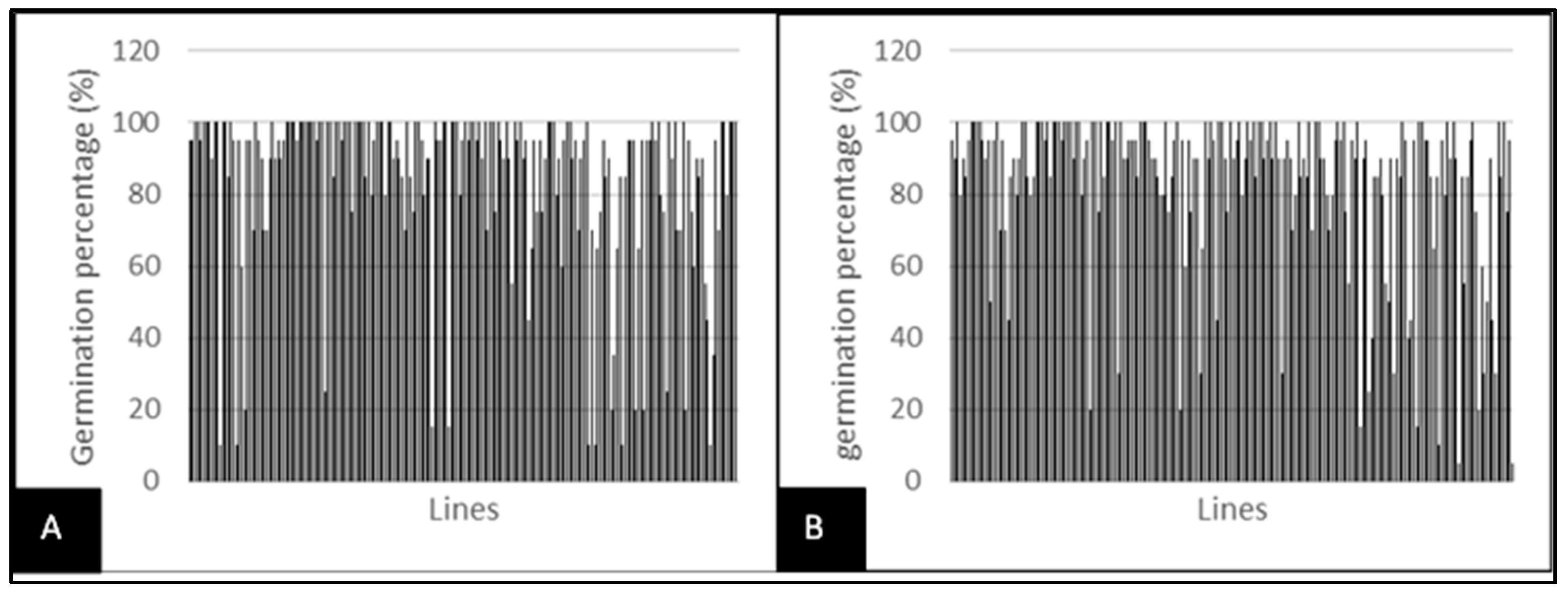

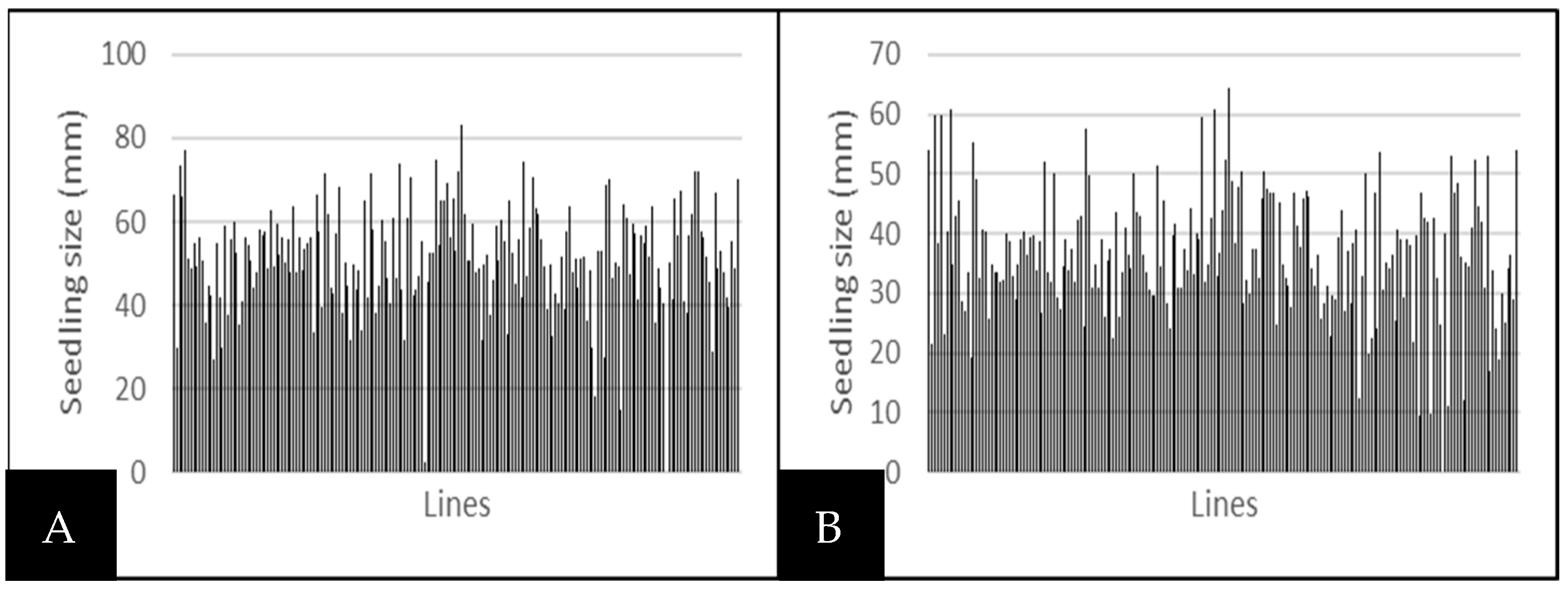
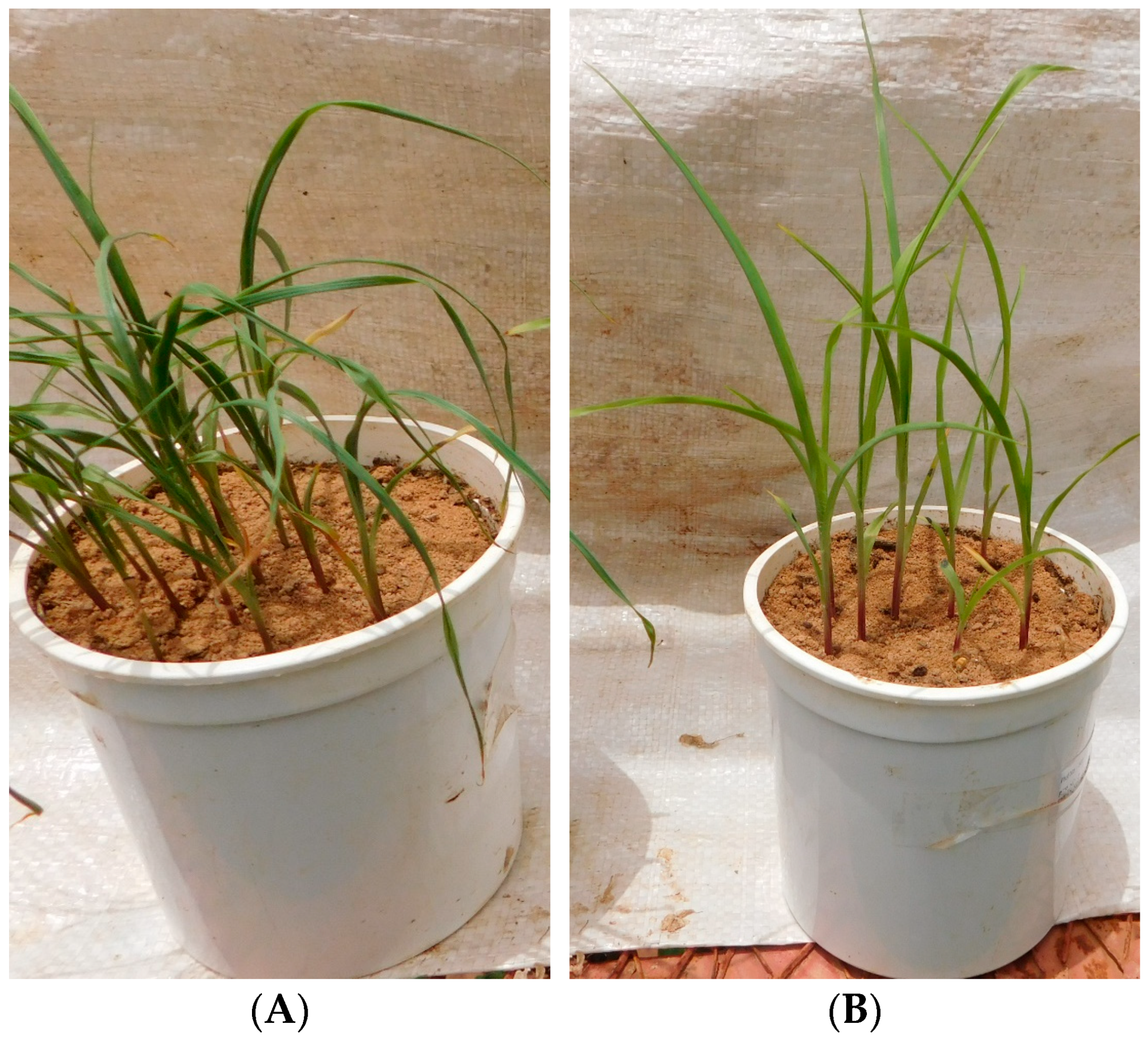
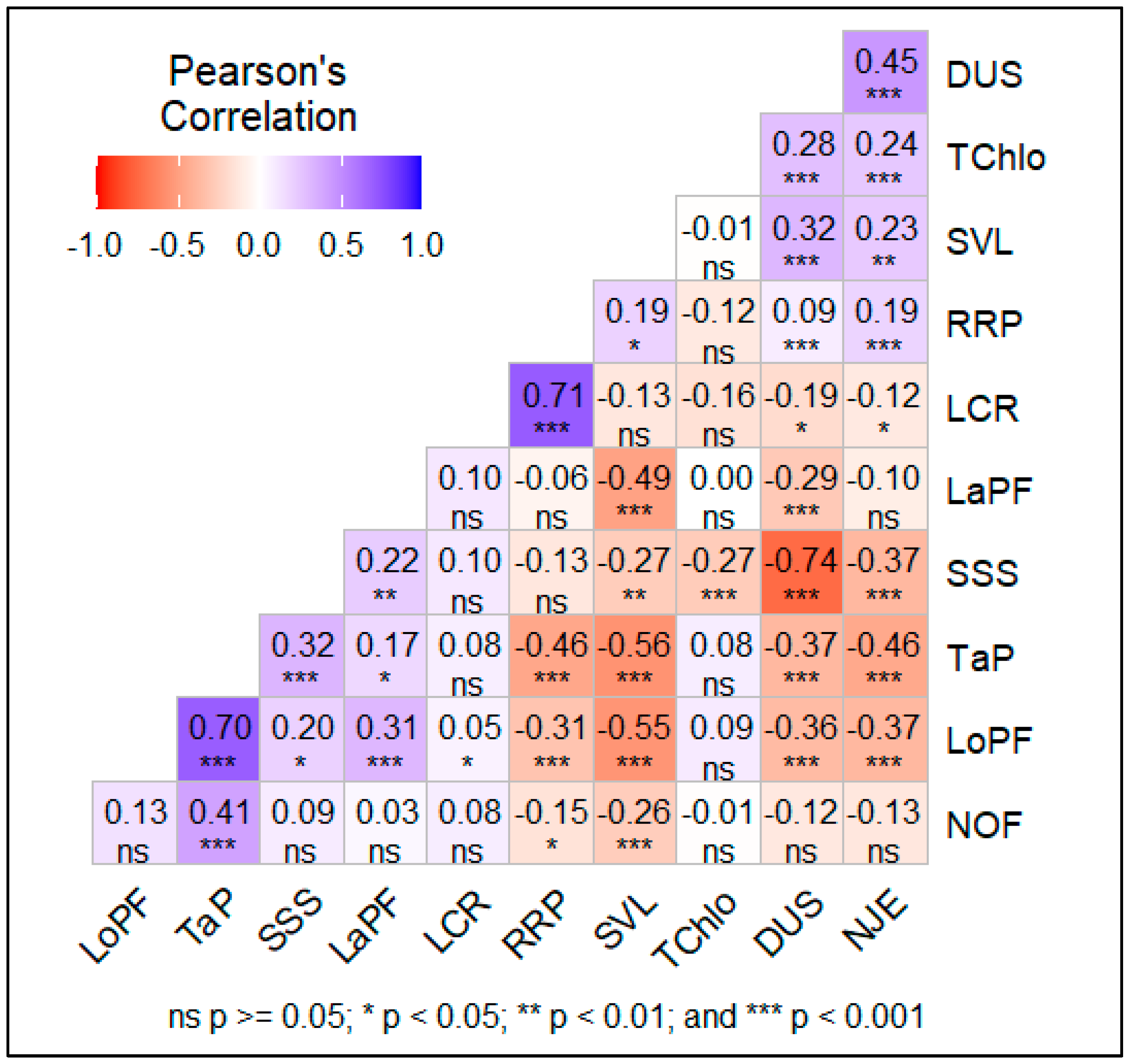
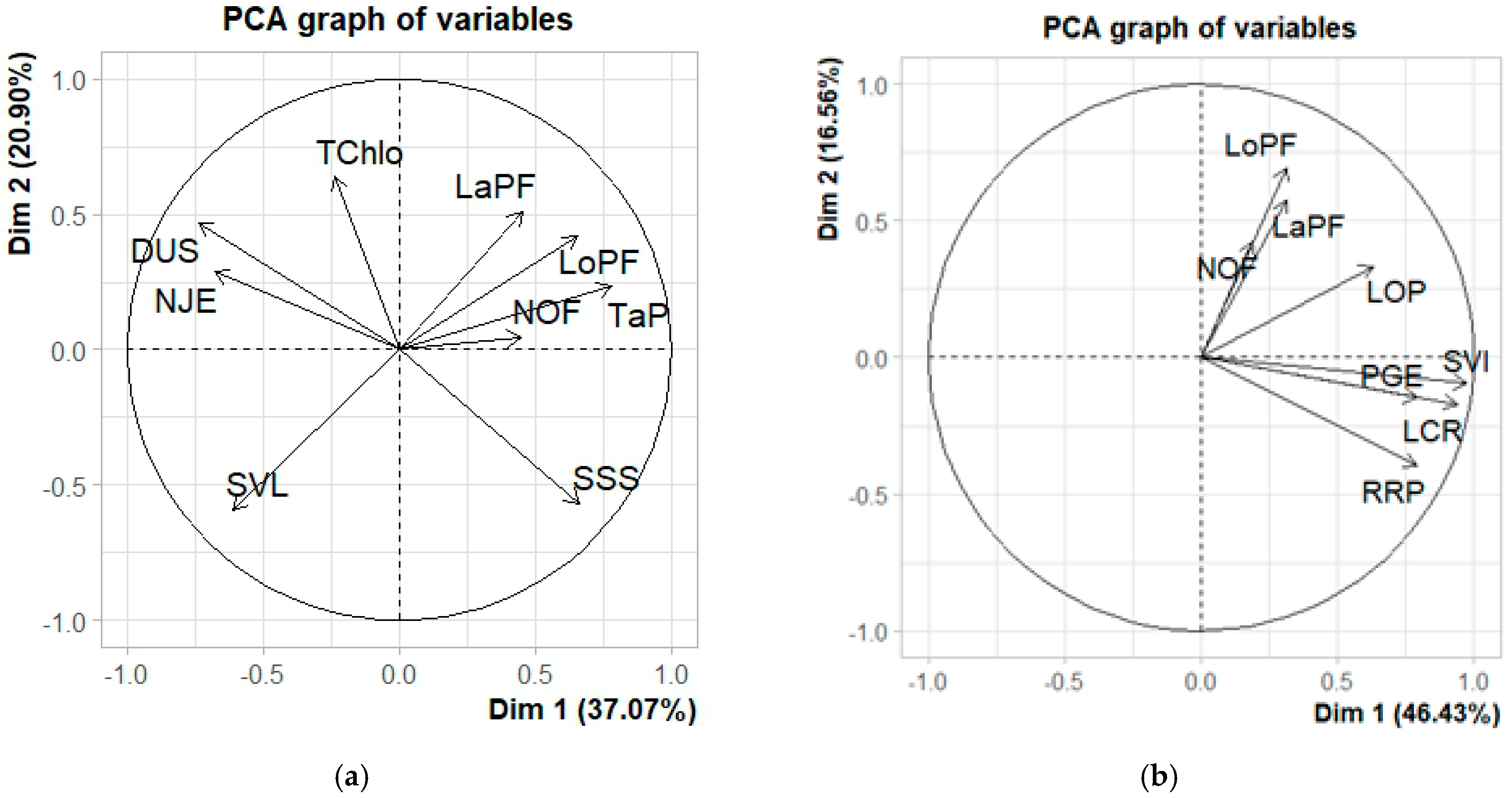
| SOV | Trt | Df | PGE | LOP | LRC | RRP | IVP |
|---|---|---|---|---|---|---|---|
| Lines | T0 | 193 | 76,169 *** | 26,279 *** | 26,038 *** | 0.9122 *** | 5013 *** |
| Residual | 115 | 7593 | 6375 | 8856 | 0.3425 | 1109 | |
| CV | 29.70 | 6.62 | 11.12 | 45.39 | 11.92 | ||
| Lines | T1 | 199 | 8758 *** | 19,112 *** | 3473 *** | 3023 *** | 5521 *** |
| Residual | 121 | 1030 | 5867 | 1107 | 1549 | 1282 | |
| CV | 28.48 | 7.94 | 12.37 | 12.43 | 12.76 | ||
| Lines | T2 | 199 | 7540 *** | 26,585 *** | 15,795 *** | 10,818 ns | 10,705 *** |
| Residual | 118 | 1373 | 9940 | 4429 | 8832 | 2235 | |
| CV | 14.17 | 2.92 | 1.88 | 2.13 | 1.48 | ||
| Lines | T3 | 199 | 9888 ** | 0.040 ns | 13,463 *** | 0.010 ns | 0.09632 ** |
| Residual | 121 | 6291 | 0.04000 | 0.6553 | 0.010 | 0.05858 | |
| CV | 8.10 | 20.00 | 7.66 | 6.44 | 9.35 |
| SOV | DUS | LCR | LaPF | LoPF | NJE | NOF | SSS | SVL | TChlo | TaP | RRP |
|---|---|---|---|---|---|---|---|---|---|---|---|
| Lines | 8.716 * | 3321.6 *** | 0.7149 *** | 253.6 *** | 1.4705 * | 0.114 ns | 0.4973 * | 0.524 *** | 78.75 ** | 1052.9 *** | 0.578 *** |
| Replication | 45.283 ** | 9610.4 ** | 0.4945 ns | 1288.1 *** | 4.2516 * | 0.20253 ns | 0.0516 ns | 0.000 ns | 737.12 *** | 612.7 ns | 2.353 ** |
| Error | 6.374 | 956.8 | 0.2633 | 101.2 | 0.995 | 0.093 | 0.368 | 0.30 | 50.77 | 436.8 | 0.2889 |
| CV | 12.11 | 10.47 | 19.96 | 5.99 | 28.89 | 18.82 | 40.88 | 30.38 | 50.30 | 7.45 | 23.74 |
| SOV | Df | PGE | LOP | LCR | RRP | IVP |
|---|---|---|---|---|---|---|
| Genotype | 199 | 742 *** | 133 *** | 1695 *** | 309 *** | 2962 *** |
| Treatment | 3 | 396,474 *** | 127,868 *** | 524,797 *** | 23,715 *** | 974,824 *** |
| Genotype × treatment | 597 | 251 | 54 | 673 | 186 | 1145 |
| IPCA 1 | 201 | 431 *** | 105 *** | 1341 *** | 434*** | 2587 *** |
| IPCA 2 | 199 | 220 *** | 48 *** | 625 *** | 0.93 *** | 792 *** |
| Residuals | 197 | 99 | 8 | 41 | 0.26 | 29 |
| Parameters | Estimate (b) | Std. Err (SE) | Z-Value | p-Value | |
|---|---|---|---|---|---|
| DUS ~ | NJE | 0.624 | 0.170 | 3.664 | 0.000 |
| DUS ~ | NOF | −0.506 | 0.600 | −843 | 0.399 |
| DUS ~ | SVL | −0.607 | 0.386 | −1.570 | 0.115 |
| DUS ~ | TaP | −0.036 | 0.011 | −3.334 | 0.001 |
| DUS ~ | LaPF | −0.764 | 0.298 | −2.565 | 0.010 |
| DUS ~ | LoPF | 0.010 | 0.015 | 0.694 | 0.488 |
| DUS ~ | TChlo | 0.104 | 0.020 | 5.068 | 0.000 |
| DUS ~ | LCR | −0.00 | 0.007 | −0.030 | 0.976 |
| DUS ~ | RRP | −0.246 | 0.546 | −0.451 | 0.652 |
| Tolerant InbredLines | PGE | LOP | LCR | RRP | IVP | ¯R | SDR | RS | R | ||||||||||
|---|---|---|---|---|---|---|---|---|---|---|---|---|---|---|---|---|---|---|---|
| R1 | R2 | R3 | R1 | R2 | R3 | R1 | R2 | R3 | R1 | R2 | R3 | R1 | R2 | R3 | |||||
| IKMLS1 18 047 | 43 | 19 | 53 | 75 | 30 | 22 | 11 | 10 | 22 | 12 | 28 | 4 | 12 | 13 | 21 | 25.0 | 19.00 | 44.00 | 1 |
| IP-16403 | 9 | 22 | 90 | 50 | 23 | 24 | 28 | 9 | 8 | 42 | 4 | 21 | 23 | 16 | 20 | 25.9 | 21.58 | 47.51 | 2 |
| IP-8172 | 48 | 2 | 65 | 104 | 29 | 20 | 2 | 3 | 6 | 5 | 7 | 18 | 6 | 3 | 3 | 21.4 | 29.55 | 50.95 | 3 |
| IKMLS1 18 039 | 16 | 3 | 37 | 49 | 1 | 1 | 45 | 5 | 3 | 66 | 70 | 59 | 42 | 1 | 1 | 26.6 | 26.71 | 53.31 | 4 |
| IP-18062 | 8 | 13 | 5 | 60 | 8 | 8 | 30 | 12 | 15 | 31 | 71 | 100 | 28 | 11 | 10 | 27.3 | 28.10 | 55.43 | 5 |
| IP-6584 | 33 | 17 | 129 | 47 | 4 | 4 | 10 | 2 | 4 | 21 | 54 | 20 | 5 | 4 | 5 | 23.9 | 33.39 | 57.33 | 6 |
| IP-4927 | 1 | 1 | 15 | 7 | 3 | 6 | 20 | 28 | 52 | 83 | 95 | 90 | 10 | 5 | 6 | 28.1 | 34.34 | 62.48 | 7 |
| IKMLS1 18,050 | 6 | 12 | 18 | 13 | 13 | 17 | 43 | 15 | 16 | 96 | 58 | 116 | 29 | 8 | 8 | 31.2 | 33.66 | 64.86 | 8 |
| IP-15857 | 55 | 6 | 28 | 114 | 17 | 13 | 36 | 20 | 20 | 23 | 60 | 75 | 50 | 9 | 7 | 35.5 | 30.28 | 65.82 | 9 |
| IP-3175 | 15 | 47 | 101 | 93 | 56 | 53 | 35 | 18 | 17 | 28 | 36 | 24 | 32 | 25 | 25 | 40.3 | 26.18 | 66.51 | 10 |
| Susceptible Inbred Lines | |||||||||||||||||||
| IKMLS1 20 099 | 186 | 195 | 13 | 147 | 138 | 148 | 190 | 189 | 99 | 189 | 160 | 163 | 193 | 192 | 54 | 150.4 | 55.15 | 205.55 | 191 |
| IP-8129 | 185 | 184 | 19 | 174 | 183 | 90 | 184 | 185 | 102 | 178 | 196 | 155 | 186 | 185 | 56 | 150.8 | 55.91 | 206.71 | 192 |
| IKMLS1 20 343 | 187 | 199 | 3 | 198 | 186 | 86 | 193 | 199 | 71 | 29 | 128 | 37 | 199 | 197 | 35 | 129.8 | 77.08 | 206.88 | 193 |
| IKMLS1 18 036 | 196 | 145 | 155 | 197 | 177 | 109 | 198 | 192 | 90 | 179 | 105 | 199 | 198 | 200 | 48 | 159.2 | 49.03 | 208.23 | 194 |
| IKMLS1 18 012 | 178 | 194 | 12 | 184 | 158 | 126 | 197 | 194 | 78 | 195 | 140 | 162 | 192 | 190 | 50 | 150.0 | 58.87 | 208.87 | 195 |
| IP-3757 | 172 | 196 | 11 | 190 | 195 | 78 | 196 | 195 | 87 | 194 | 129 | 160 | 190 | 191 | 61 | 149.7 | 61.25 | 210.91 | 196 |
| IKMLS1 20 134 | 195 | 122 | 197 | 192 | 198 | 95 | 195 | 200 | 109 | 197 | 173 | 194 | 189 | 198 | 75 | 168.6 | 44.12 | 212.72 | 197 |
| IKMS1 20,882 | 200 | 130 | 181 | 199 | 199 | 48 | 185 | 187 | 108 | 200 | 139 | 190 | 197 | 195 | 45 | 160.2 | 54.34 | 214.54 | 198 |
| IKMLS1 18 001 | 198 | 131 | 180 | 193 | 189 | 77 | 199 | 197 | 73 | 199 | 163 | 192 | 195 | 193 | 44 | 161.5 | 53.62 | 215.15 | 199 |
| IKMLS1 18 046 | 197 | 170 | 75 | 200 | 200 | 45 | 200 | 198 | 74 | 198 | 182 | 195 | 200 | 199 | 42 | 158.3 | 63.08 | 221.42 | 200 |
Disclaimer/Publisher’s Note: The statements, opinions and data contained in all publications are solely those of the individual author(s) and contributor(s) and not of MDPI and/or the editor(s). MDPI and/or the editor(s) disclaim responsibility for any injury to people or property resulting from any ideas, methods, instructions or products referred to in the content. |
© 2025 by the authors. Licensee MDPI, Basel, Switzerland. This article is an open access article distributed under the terms and conditions of the Creative Commons Attribution (CC BY) license (https://creativecommons.org/licenses/by/4.0/).
Share and Cite
Bazie, L.V.; Drabo, I.; Some, K.; Rouamba, A.; Bationo, P. Response of Pearl Millet (Pennisetum glaucum [L.] R. Br.) Growth to Post-Emergence Water Stress. Agronomy 2025, 15, 2321. https://doi.org/10.3390/agronomy15102321
Bazie LV, Drabo I, Some K, Rouamba A, Bationo P. Response of Pearl Millet (Pennisetum glaucum [L.] R. Br.) Growth to Post-Emergence Water Stress. Agronomy. 2025; 15(10):2321. https://doi.org/10.3390/agronomy15102321
Chicago/Turabian StyleBazie, Lazare Vourbouè, Inoussa Drabo, Koussao Some, Armel Rouamba, and Pauline Bationo (Kando). 2025. "Response of Pearl Millet (Pennisetum glaucum [L.] R. Br.) Growth to Post-Emergence Water Stress" Agronomy 15, no. 10: 2321. https://doi.org/10.3390/agronomy15102321
APA StyleBazie, L. V., Drabo, I., Some, K., Rouamba, A., & Bationo, P. (2025). Response of Pearl Millet (Pennisetum glaucum [L.] R. Br.) Growth to Post-Emergence Water Stress. Agronomy, 15(10), 2321. https://doi.org/10.3390/agronomy15102321







